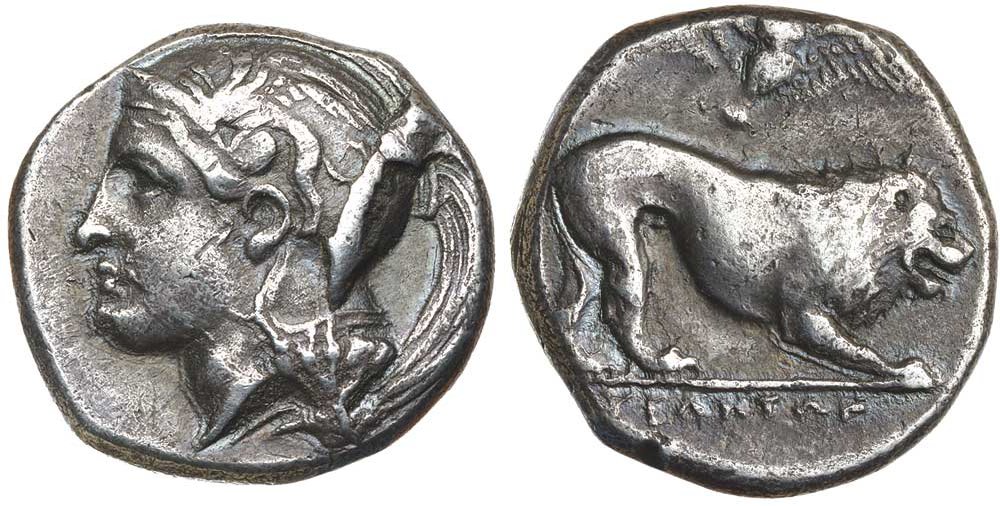Velia, silver, didrachms (400-365 BCE)
From SILVER
400 BCE - 365 BCE Silver 2,973 kg
Description
| ObverseInscription or printing placed on the obverse.: | Several types: 1) Lion walking right, 2) Head of nymph right, 3) Head of Athena left, wearing Corinthian helmet |
| ReverseInscription or printing placed on the reverse.: | YEΛHTEΩN (Greek).Several types: here, lion walking to right, owl above lion with open wings |
Mint and issuing power
| MintIdentifies the place of manufacture or issue of a numismatic object.: | Velia | Ancient regionAncient region.: | Lucania | Modern countryModern country: Italy | AuthorityIdentifies the issuing power. The authority can be "pretended" when the name or the portrait of X is on the coin but he/she was not the issuing power. It can also be "uncertain" when there is no mention of X on the coin but he/she was the issuing power according to the historical sources: |
Chronology
| FromIdentifies the initial date in a range assigned in a numismatic context. | 400 BCE | toIdentifies the final date in a range assigned in a numismatic context.. | 365 BCE | PeriodTime period of the numismatic object.: Classical 480-323 BC |
Physical description
| MetalThe physical material (usually metal) from which an object is made.: | Silver |
Median weightMedian of the weights of numismatic objects (in grams). in grams | 7.60 | DenominationTerm indicating the value of a numismatic object. Examples: tetradrachm, chalkous, denarius.: | didrachm |
StandardStandard.: |
Image

AC 15 - Velia, silver, didrachm, 400-365 BC.jpg [1]
References
| Die study referencePublication of the study: | Williams 19921Williams 1992, Groupe II: variétés 209-250 (D129-D148 et R162-R196) | ||
| Coin series referenceReference to coin series study: | Sear I2Sear I, n° 451 and 453, RQEMAC3RQEMAC, n° 15, HN Italy4HN Italy, 1276-1278, HGC 15HGC 1, n° 1309 | ||
Obverse dies distribution
| FrequencyFrequency of specimen in distribution. ᵖ | Number of obversesNumber of obverse dies. ᵖ (o) | % (o) | Number of coinsNumber of coins. (n) | % (n) | Die nameName(s) of the die(s). |
| 1 | 1 | 5 | 1 | 0.27 | 143 |
| 4 | 1 | 5 | 4 | 1.1 | 147 |
| 5 | 2 | 10 | 10 | 2.75 | 146, 148 |
| 6 | 1 | 5 | 6 | 1.65 | 144 |
| 9 | 1 | 5 | 9 | 2.47 | 137 |
| 10 | 1 | 5 | 10 | 2.75 | 140 |
| 13 | 1 | 5 | 13 | 3.57 | 142 |
| 14 | 1 | 5 | 14 | 3.85 | 131 |
| 16 | 1 | 5 | 16 | 4.4 | 139 |
| 17 | 2 | 10 | 34 | 9.34 | 136, 141 |
| 19 | 1 | 5 | 19 | 5.22 | 135 |
| 21 | 1 | 5 | 21 | 5.77 | 145 |
| 23 | 1 | 5 | 23 | 6.32 | 133 |
| 25 | 1 | 5 | 25 | 6.87 | 130 |
| 30 | 1 | 5 | 30 | 8.24 | 134 |
| 31 | 1 | 5 | 31 | 8.52 | 132 |
| 45 | 1 | 5 | 45 | 12.36 | 129 |
| 53 | 1 | 5 | 53 | 14.56 | 138 |
| Total | 20 of 20 | 100 | 364 of 364 | 100.01 |
Reverse dies distribution
no distribution is available
Quantification
| Number of obversesNumber of obverse dies. ᵖ (o) | 20 | Number of singletons (o1)The number of singleton coins. ᵖ | 1 |
| Number of reverse diesNumber of reverse dies. (r) | 35 | Number of coinsNumber of coins. (n) | 364 |
| Coins per obverse dieNumber of coins per obverse die. (n/o) | 18.2 | Coins per reverse dieNumber of coins per reverse die. (n/r) | 10.4 |
| Reverse per obverse ratioRatio of obverse dies divided by reverse dies. (r/o) | 1.75 | Percentage of singletons (o1)number of coins (n) divided by the number of singletons (o1) ᵖ | 5 % |
| Original number of dies (O) (Carter 1983 formula)The estimation of the number of coins according to Carter 1983 ᵖ | 19.56 | Coins struck if 20,000 as average productivity per dieCoins made if the average productivity for obverses (according to Carter) is 20,000. ᵖ | 391,200 |
| Original number of dies (O) (Esty 2011 formula)The estimation of the number of coins according to the singleton formula in Esty 2011 ᵖ (O) | 21.16 | Survival rate if 20,000 as average productivity per dieSurvival rate if average productivity is 20,000. ᵖ | 0.00093 |
| Coverage (o = % of O) (Esty 1984 formula)Esty 1984 - coverage (% of O) ᵖ (o = % of O) | 99.73% | Die productivity if survival rate 1/2,000Average productivity if survival rate is 1/2,000. ᵖ | 37,218.81 |
| Weight of silver (in kg) if 20,000 coins per die (O = Carter formula)Carter 1983 * Median weight * 20000 (*10 if gold or electrum) ᵖ | 2,973 kg <br /> 2,973 kg | Die productivity if survival rate 1/5,000Average productivity if survival rate is 1/5,000. ᵖ | 93,047.03 |
Remarks